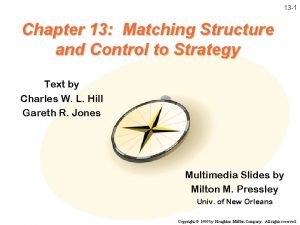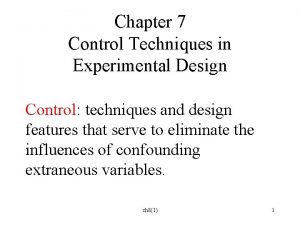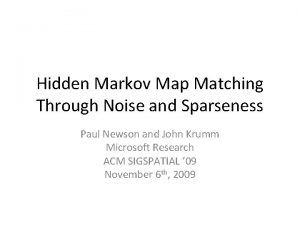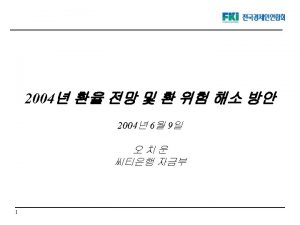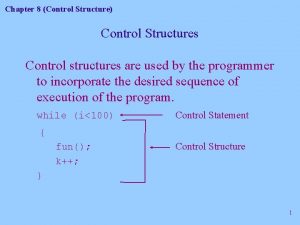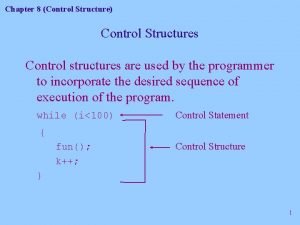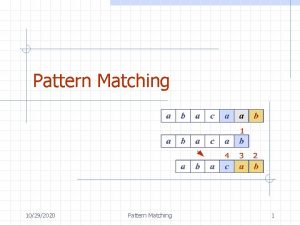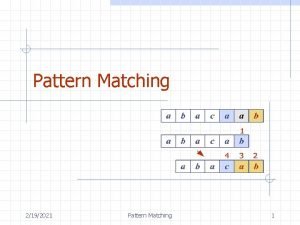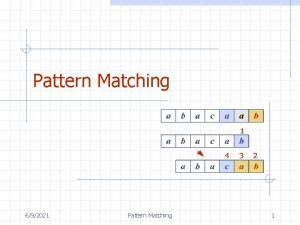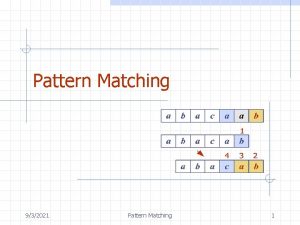13 1 Chapter 13 Matching Structure and Control





















- Slides: 21

13 -1 Chapter 13: Matching Structure and Control to Strategy Text by Charles W. L. Hill Gareth R. Jones Multimedia Slides by Milton M. Pressley Univ. of New Orleans Copyright ã 1998 by Houghton Mifflin Company. All rights reserved.

13 -2 Preview 4 Structure and Control at the Functional Level 4 Structure and Control at the Business Level 4 Designing a Global Structure 4 Structure and Control at the Corporate Level 4 Special Issues in Strategy. Structure Choice Copyright ã 1998 by Houghton Mifflin Company. All rights reserved.

13 -3 Structure and Control at the Functional Level • • • Manufacturing Research and Development Sales Copyright ã 1998 by Houghton Mifflin Company. All rights reserved.

Structure and Control at the Business Level 13 -4 Table 13. 1: Generic Strategy, Structure, and Control STRATEGY Cost Leadership Appropriate Structure Integrating Mechanisms Output Control Bureaucratic Control Organizational Culture Differentiation Focus Functional Center on Manufacturing Great Use (e. g. , cost control Some Use (e. g. , budgets, standardization) Little Use (e. g. , quality control circles) f Copyright ã 1998 by Houghton Mifflin Company. All rights reserved.

Structure and Control at the Business Level 13 -5 Table 13. 1: Generic Strategy, Structure, and Control Cost Leadership Appropriate Structure Integrating Mechanisms Output Control Functional Bureaucratic Control Some Use (e. g. , budgets, standardization) Little Use (e. g. , quality control circles) Organizational Culture Center on Manufacturing Great Use (e. g. , cost control STRATEGY Differentiation Focus Product-team or Matrix Center on R&D or Marketing Some Use (e. g. , quality goals) Great Use (e. g. , rules, budgets) Great Use (e. g. , norms and values) f Copyright ã 1998 by Houghton Mifflin Company. All rights reserved.

Structure and Control at the Business Level 13 -6 Table 13. 1: Generic Strategy, Structure, and Control STRATEGY Cost Leadership Differentiation Focus Appropriate Structure Integrating Mechanisms Functional Product-team or Matrix Functional Center on Manufacturing Center on R&D or Marketing Output Control Great Use (e. g. , cost control Bureaucratic Control Some Use (e. g. , budgets, standardization) Little Use (e. g. , quality control circles) Some Use (e. g. , quality goals) Great Use (e. g. , rules, budgets) Great Use (e. g. , norms and values) Center on Product or Customer Some Use (e. g. , cost and quality) Some Use (e. g. , budgets) Organizational Culture Great Use (e. g. , norms and values) f Copyright ã 1998 by Houghton Mifflin Company. All rights reserved.

13 -7 Designing a Global Structure Recall from Chapter 8: 4 Multidomestic Strategy 4 International Strategy 4 Global Strategy 4 Transnational Strategy Copyright ã 1998 by Houghton Mifflin Company. All rights reserved.

Designing a Global Structure (Continued) 13 -8 Table 13. 2: Global Strategy-Structure Relationships Centralization of Authority Multidomestic Low Decentralized to National Unit International Global Need for Coordination Bureaucratic Costs Horizontal Differentiation Global Area Structure Competencies Centralized. Others Decentralized to National Units International Division Structure Need for Complex Integrating Mechanisms Low Medium Organizational Culture Not Important Quite Important Centralized at Optimal Global Location Transnational High Simultaneously Centralized and Decentralized Global Pro-duct Group Structure High Global Matrix Structure Important Very High Copyright ã 1998 by Houghton Mifflin Company. All rights reserved.

13 -9 Figure 13. 1: Global Area Structure Corporate Headquarters North American Region South American Region European Region Pacific Region Copyright ã 1998 by Houghton Mifflin Company. All rights reserved.

Designing a Global Structure (Continued) 13 -10 Table 13. 2: Global Strategy-Structure Relationships Multidomestic Low Decentralized to National Unit International Need for Coordination Bureaucratic Costs Horizontal Differentiation Global Area Structure Competencies Centralized. Others Decentralized to National Units International Division Structure Need for Complex Integrating Mechanisms Low Medium Organizational Culture Not Important Quite Important Centralization of Authority Global Centralized at Optimal Global Location Transnational High Simultaneously Centralized and Decentralized Global Pro-duct Group Structure High Global Matrix Structure Important Very High Copyright ã 1998 by Houghton Mifflin Company. All rights reserved.

13 -11 Figure 13. 2: International Division Structure Corporate Headquarters Product Group 1 United States Product Group 2 United Kingdom Product Group 3 Japan France Copyright ã 1998 by Houghton Mifflin Company. All rights reserved.

Designing a Global Structure (Continued) 13 -12 Table 13. 2: Global Strategy-Structure Relationships Centralization of Authority Multidomestic Low Decentralized to National Unit International Global Need for Coordination Bureaucratic Costs Horizontal Differentiation Global Area Structure Competencies Centralized. Others Decentralized to National Units International Division Structure Need for Complex Integrating Mechanisms Low Medium Organizational Culture Not Important Quite Important Centralized at Optimal Global Location Transnational High Simultaneously Centralized and Decentralized Global Pro-duct Group Structure High Global Matrix Structure Important Very High Copyright ã 1998 by Houghton Mifflin Company. All rights reserved.

Figure 13. 3: Global Product Group Structure 13 -13 Corporate Headquarters Division 1 Division 2 Division 3 International Division United States United Kingdom Japan France Copyright ã 1998 by Houghton Mifflin Company. All rights reserved.

Designing a Global Structure (Continued) 13 -14 Table 13. 2: Global Strategy-Structure Relationships Centralization of Authority Multidomestic Low Decentralized to National Unit International Global Need for Coordination Bureaucratic Costs Horizontal Differentiation Global Area Structure Competencies Centralized. Others Decentralized to National Units International Division Structure Need for Complex Integrating Mechanisms Low Medium Organizational Culture Not Important Quite Important Centralized at Optimal Global Location Transnational High Simultaneously Centralized and Decentralized Global Product Group Structure High Global Matrix Structure Important Very High Copyright ã 1998 by Houghton Mifflin Company. All rights reserved.

13 -15 Figure 13. 4: Global Matrix Structure N. American SBU S. American SBU Pacific SBU Product Group 1 Product Group 2 Product Group 3 Individual Operating Companies Copyright ã 1998 by Houghton Mifflin Company. All rights reserved.

Designing a Global Structure (Continued) 13 -16 Table 13. 2: Global Strategy-Structure Relationships Centralization of Authority Multidomestic Low Decentralized to National Unit International Global Need for Coordination Bureaucratic Costs Horizontal Differentiation Global Area Structure Competencies Centralized. Others Decentralized to National Units International Division Structure Need for Complex Integrating Mechanisms Low Medium Organizational Culture Not Important Quite Important Centralized at Optimal Global Location Transnational High Simultaneously Centralized and Decentralized Global Product Group Structure High Global Matrix Structure Important Very High Copyright ã 1998 by Houghton Mifflin Company. All rights reserved.

13 -17 Structure and Control at the Corporate Level Table 13. 3: Corporate Strategy and Structure and Control Type of Control Corporate Strategy Appropriate Structure Need for Integration Financial Behavior Unrelated Diversification Multidivisional Great Use (e. g. , ROI) Some Use (e. g. , Budgets) Vertical Integration Multidivisional Low (No Exchanges Between Divisions) Medium (Scheduling Resource Transfers) Great Use (e. g. , ROI, Transfer Pricing) Related Diversification Multidivisional High (Achieve Synergies Between Divisions by Integrating Roles) Little Use Great Use (e. g. , Standardization, Budgets) Great use (e. g. , Rules, Budgets) Organizational Culture Little Use Some Use (e. g. , Shared Norms and Values Great use (e. g. , Norms, Values, Common Language) Copyright ã 1998 by Houghton Mifflin Company. All rights reserved.

13 -18 Structure and Control at the Corporate Level Table 13. 3: Corporate Strategy and Structure and Control Type of Control Corporate Strategy Appropriate Structure Need for Integration Financial Behavior Unrelated Diversification Multidivisional Great Use (e. g. , ROI) Some Use (e. g. , Budgets) Vertical Integration Multidivisional Low (No Exchanges Between Divisions) Medium (Scheduling Resource Transfers) Great Use (e. g. , ROI, Transfer Pricing) Related Diversification Multidivisional High (Achieve Synergies Between Divisions by Integrating Roles) Little Use Great Use (e. g. , Standardization, Budgets) Great use (e. g. , Rules, Budgets) Organizational Culture Little Use Some Use (e. g. , Shared Norms and Values) Great use (e. g. , Norms, Values, Common Language) Copyright ã 1998 by Houghton Mifflin Company. All rights reserved.

13 -19 Structure and Control at the Corporate Level Table 13. 3: Corporate Strategy and Structure and Control Type of Control Corporate Strategy Appropriate Structure Need for Integration Financial Behavior Unrelated Diversification Multidivisional Great Use (e. g. , ROI) Some Use (e. g. , Budgets) Vertical Integration Multidivisional Low (No Exchanges Between Divisions) Medium (Scheduling Resource Transfers) Great Use (e. g. , ROI, Transfer Pricing) Related Diversification Multidivisional High (Achieve Synergies Between Divisions by Integrating Roles) Little Use Great Use (e. g. , Standardization, Budgets) Great use (e. g. , Rules, Budgets) Organizational Culture Little Use Some Use (e. g. , Shared Norms and Values) Great use (e. g. , Norms, Values, Common Language) Copyright ã 1998 by Houghton Mifflin Company. All rights reserved.

13 -20 Special Issues in Strategy-Structure Choice • Mergers, Acquisitions, and Structure • Internal New Ventures and Structure • Network Structure and the Virtual Organization Copyright ã 1998 by Houghton Mifflin Company. All rights reserved.

13 -21 Chapter Summary L O R T N O C D N A E R U T C U R 4 ST AT THE FUNCTIONAL LEVEL E H T T A L O R T N O C D N A 4 STRUCTURE BUSINESS LEVEL E R U T C U R T S L A B O L G 4 DESIGNING A E H T T A L O R T N O C D N A E 4 STRUCTUR CORPORATE LEVEL Y G E T A R T S IN S E U S IS L IA 4 SPEC STRUCTURE CHOICE Copyright ã 1998 by Houghton Mifflin Company. All rights reserved.
 Matching structure
Matching structure Matching by yoked control
Matching by yoked control Case control matching spss
Case control matching spss Implementing strategies management and operations issues
Implementing strategies management and operations issues Comprehensive strategic management model
Comprehensive strategic management model Chapter 16 matching question 6-10
Chapter 16 matching question 6-10 Introduction to medical terminology chapter 1
Introduction to medical terminology chapter 1 Chapter 19 matching words with definitions
Chapter 19 matching words with definitions Chapter 13 sentence check 1 answer key
Chapter 13 sentence check 1 answer key Product control
Product control What is a positive control
What is a positive control Flow and error control
Flow and error control Hidden markov map matching through noise and sparseness
Hidden markov map matching through noise and sparseness Efficient private matching and set intersection
Efficient private matching and set intersection Supply & demand matching
Supply & demand matching Matching muscle directions and positions
Matching muscle directions and positions Jingles are the message written around the brand
Jingles are the message written around the brand Netting and matching
Netting and matching Matching supply and demand in supply chain
Matching supply and demand in supply chain Patient identification and procedure matching
Patient identification and procedure matching Voltage standing wave ratio
Voltage standing wave ratio Bassoon peter and the wolf
Bassoon peter and the wolf
